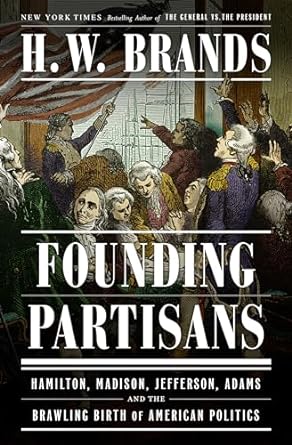H.W. Brands
Doubleday

What Washington deemed an awful crisis, Alexander Hamilton accounted an opportunity. Some of the difference was temperamental. Washington preferred calm, while Hamilton thrived on uproar, to the extent of creating his own when circumstances didn’t provide enough. But some reflected the different arcs of their careers. Washington expected that his days of great accomplishment were over; he currently enjoyed all the esteem his ego desired. Hamilton’s career had hardly started, his egotism was far from sated, and every crack in the status quo afforded an avenue he might exploit to advance himself.
from Founding Partisans
A timely reminder of our partisan past
Time has a way of smoothing out history’s wrinkles. Today we picture the “Founding Fathers” standing unified and statuesque in their powdered wigs and rectitude. But H. W. Brands, professor of history at the University of Texas at Austin, reminds us just how fraught and tumultuous those early years were.
In 1787, Congress was seen as hapless, dysfunctional, corrupt, taking too long to make decisions, and when they did, the decisions were wrong. So different from today. Everyone agreed that the Articles of Confederation that held the thirteen former colonies together were inadequate, and so a convention was called to come up with a better constitution. This was Do-It-Yourself Government, they were making it up as they went.
The delegates came to the convention with their special interests and their special egos, along with their distrust and dislike of one another, where they argued over a host of issues: the huge debt (yes, our nation began with a huge debt), deciding who could vote, who could levy taxes, whether there should be a national bank, the continuation or elimination of slavery, even arguing over the location of the capital: Philadelphia, or New York, or maybe some Virginia swampland they could get cheap on the Potomac.
They were brilliant men who had competing visions for the new nation, visions we are still wrestling with 250 years later. The Federalists (John Adams, Alexander Hamilton) wanted a strong central government to stand up to the European heavyweights, while the Anti-Federalists, later called Republicans (Jefferson, Madison) were wary of a federal government, wanting the power to remain with the states and the people—white, propertied, male-type people.
Above the fray sat Washington in his aloof eminence. He did not possess Hamilton’s brilliance, or Jefferson’s eloquence, or Adams’ passionate, self-righteous zeal. What he did possess was character, integrity, and the people’s trust. At the end of his first term as president, both parties begged—or this being the 18th century, beseeched—him to accept a second term, fearful that the young American experiment would collapse without him.
For the casual reader, this book may get too much into the nuts and bolts of building a government. Brands also relies heavily on the actual words from the founders’ letters and diaries. Such “loquaciousness” can be a challenge in our stripped-down Twitter-verse of text messages.
Eventually, these partisan patriots brought forth the US Constitution. Rather than the crowning achievement as we see it today, it was considered a compromise document leaving no one happy. Instead of the joyous celebrations and bell ringing that greeted the Declaration of Independence 11 years earlier, the Constitution was ratified grudgingly as the best they could agree upon. And we’ve been arguing pretty much ever since.
This review first appeared in The Columbia River Reader (January 15, 2024.) Reprinted with permission.



